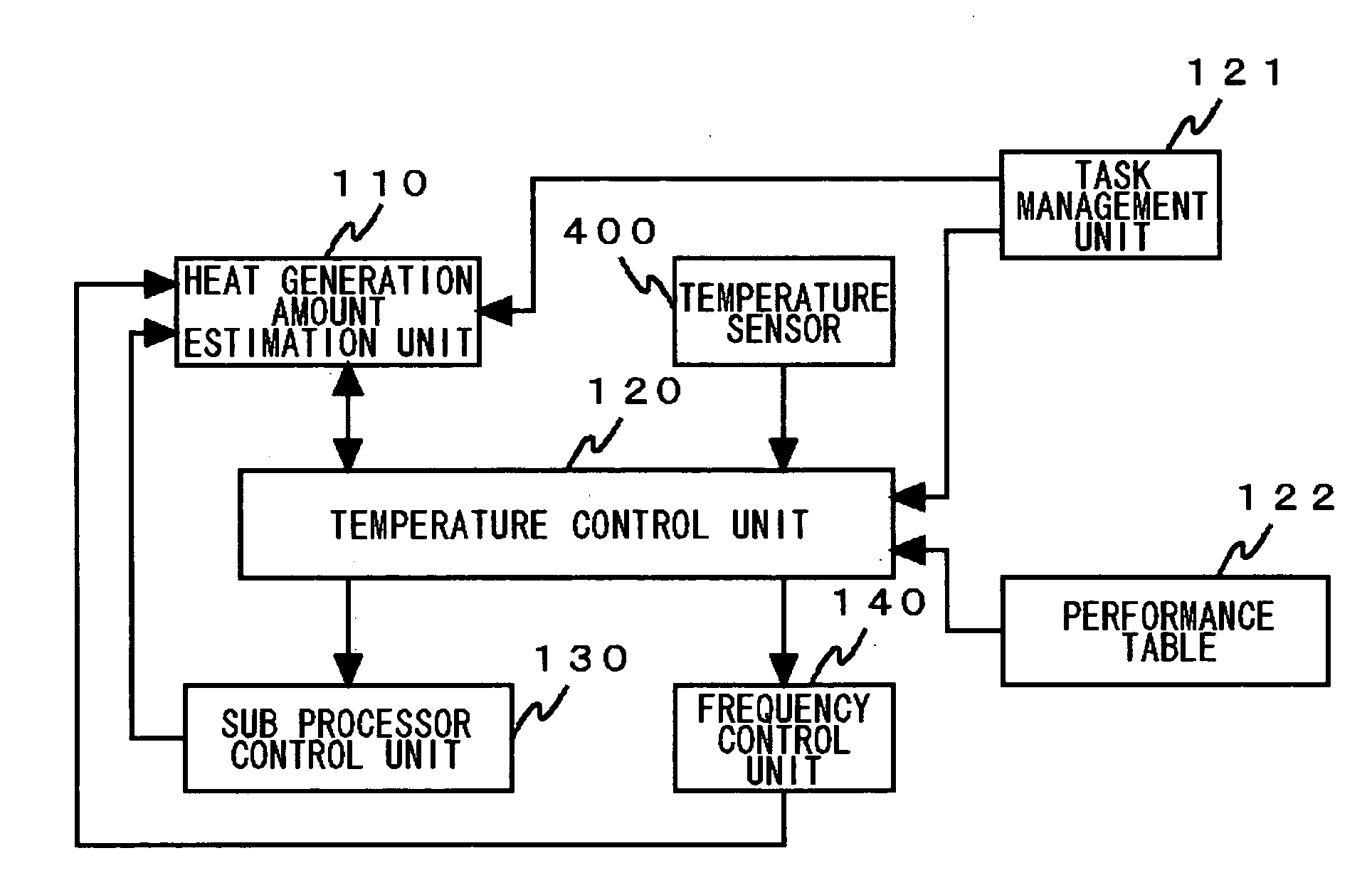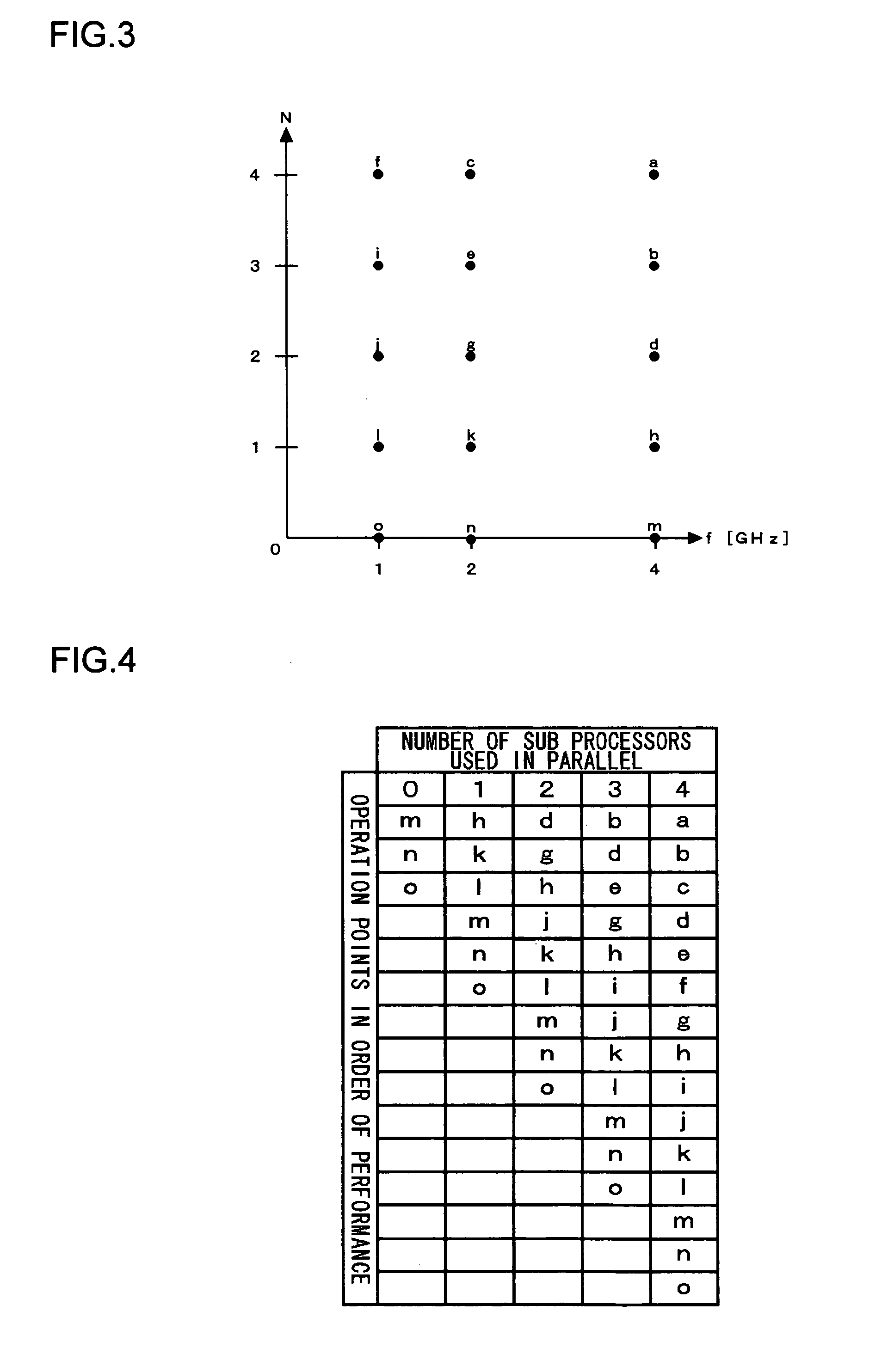Processor for controlling performance in accordance with a chip temperature, information processing apparatus, and mehtod of controlling processor
- Summary
- Abstract
- Description
- Claims
- Application Information
AI Technical Summary
Benefits of technology
Problems solved by technology
Method used
Image
Examples
first embodiment
[0030]FIG. 1 is a diagram showing the configuration of a processor according to a first embodiment. The processor 1 includes, in its chip, a main processor 100, four first to fourth sub processors 200a to 200d, a memory unit 300, and a temperature sensor 400. These components are connected with not-shown buses. The sub processors 200 are not limited to four in number, but may be provided in any arbitrary number. For example, eight sub processors may be provided. These components are not limited to the layout pattern shown in FIG. 1, either, but may be arranged arbitrarily. A clock generating unit 500 supplies a basic frequency to the processor 1.
[0031] The main processor 100 controls the entire processor 1. In particular, it manages the first to fourth sub processors 200a to 200d, and allocates tasks among these as appropriate. The main processor 100 also exercises temperature management, power management, and performance management. The first to fourth sub processors 200a to 200d ...
second embodiment
[0047] A second embodiment will deal with the case where the estimated amount of heat generation E is not determined by calculation as in the first embodiment, but is registered in a table in advance. FIG. 6 is a diagram showing functional blocks according to the second embodiment, which are realized chiefly by the cooperation of the main processor 100, the memory unit 300, and software programs loaded into the memory unit 300. A task table 115 contains task by task the number of sub processors 200 available in parallel and the amount of heat generation. FIG. 7 is a chart showing the task table 115. Task types include, for example, key-entry wait, MPEG data decoding, and voice recognition. The number of sub processors 200 available in parallel varies from one task to another. With tasks that must be performed by the main processor 100 alone, the number is zero. With tasks capable of parallel processing, the number is one or above. The amounts of heat generation are task-specific amo...
third embodiment
[0053] A third embodiment will deal with the case where a plurality of temperature sensors 400 are provided in the chip. FIG. 8 is a diagram showing the configuration of a processor according to the third embodiment. The processor 1 includes, in its chip, a main processor 100, four first to fourth sub processors 200a to 200d, a memory unit 300, and four first to fourth temperature sensors 400a to 400d. The first temperature sensor 400a measures the temperature of the block a, and the second temperature sensor 400b the temperature of the block b. The same holds for the third temperature sensor 400c and the fourth temperature sensor 400d. The temperature sensors 400 are not limited to four in number, but may be provided in any arbitrary number. For example, two temperature sensors may be provided. They are not limited to the layout pattern shown in FIG. 8, either, but may be arranged arbitrarily. The rest of the configuration is the same as described in FIG. 1.
[0054] The third embodi...
PUM
 Login to View More
Login to View More Abstract
Description
Claims
Application Information
 Login to View More
Login to View More - R&D
- Intellectual Property
- Life Sciences
- Materials
- Tech Scout
- Unparalleled Data Quality
- Higher Quality Content
- 60% Fewer Hallucinations
Browse by: Latest US Patents, China's latest patents, Technical Efficacy Thesaurus, Application Domain, Technology Topic, Popular Technical Reports.
© 2025 PatSnap. All rights reserved.Legal|Privacy policy|Modern Slavery Act Transparency Statement|Sitemap|About US| Contact US: help@patsnap.com



